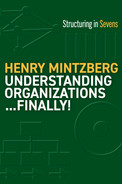PART VI
BALANCING THE FORCES ACROSS THE FORMS
It has been said that there are two kinds of people in the world: those who believe there are two kinds of people and those who don’t. I’m not sure about that, but I do know that there are the lumpers of the world and there are the splitters (a distinction first made by Charles Darwin117). One synthesizes, the other analyzes. The lumpers create categories, according to the similarities in phenomena; the splitters zero in on the differences, and so like to take apart the lumps (and sometimes the lumpers too).
I am a consummate lumper, as you may have noticed—in this book, about seven lumps of organizing. The original version of the book brought out the splitters, who criticized its lumping. (One academic even referred to this, and related works by Danny Miller, as “McGillomania,” in reference to our university.118) Practicing managers, however, have tended to be more sympathetic to the lumping—they have to get on with life instead of splitting theories.
Lumping, albeit imperfect, has certain benefits. It simplifies the complexities and appeals to our sense of order. Organizations can be quickly and easily understood—and, of course, misunderstood. When a form does fit, more or less, it can help to manage an organization— for example, by suggesting possible causes for problems that arise. In truth, we can’t function without lumps. After all, words are lumps, namely categories. (Consider lumper, splitter, and McGillomania.) We would still be grunting at each other in caves without these word lumps. Hence, for clarification, for comprehension, for diagnosis, and for prescription, we need lumping.

FIGURE VI.1 Forces Across the Forms
And so, fit where necessary, but not necessarily fit. We can’t ignore the limitations of lumping, any more than the benefits of splitting. There is always the nuancing of gray between the categorizing of black and white. Hence, the perspective I wish to advance at this point in the book is that our lumping has to be modified by splitting. Put differently, we need to let the forces speak to the forms. Along our way, in fact, we have seen numerous anomalies in the forms, such as football players who require extensive training in this most programmed of sports and project organizations that need controllers to keep a lid on the volatility.
Of course, these are not anomalies, but reality—natural occurrences in organizations. They can be seen, in the diamond diagram repeated in Figure VI.1, in three aspects. Chapter 17 makes the case for anchored forms as preferable to pure forms. Chapter 18 introduces all sorts of hybrids of the forms, where two or more forces logically coexist in some kind of dynamic balance. And because organizations don’t always hold still, Chapter 19 lays out a life cycle of transitions across the forms, when one prevalent force, or a combination of them, replaces another. It is especially these three chapters that map the space inside the diamond diagram, with the four forms at the nodes, to which the forces speak.
